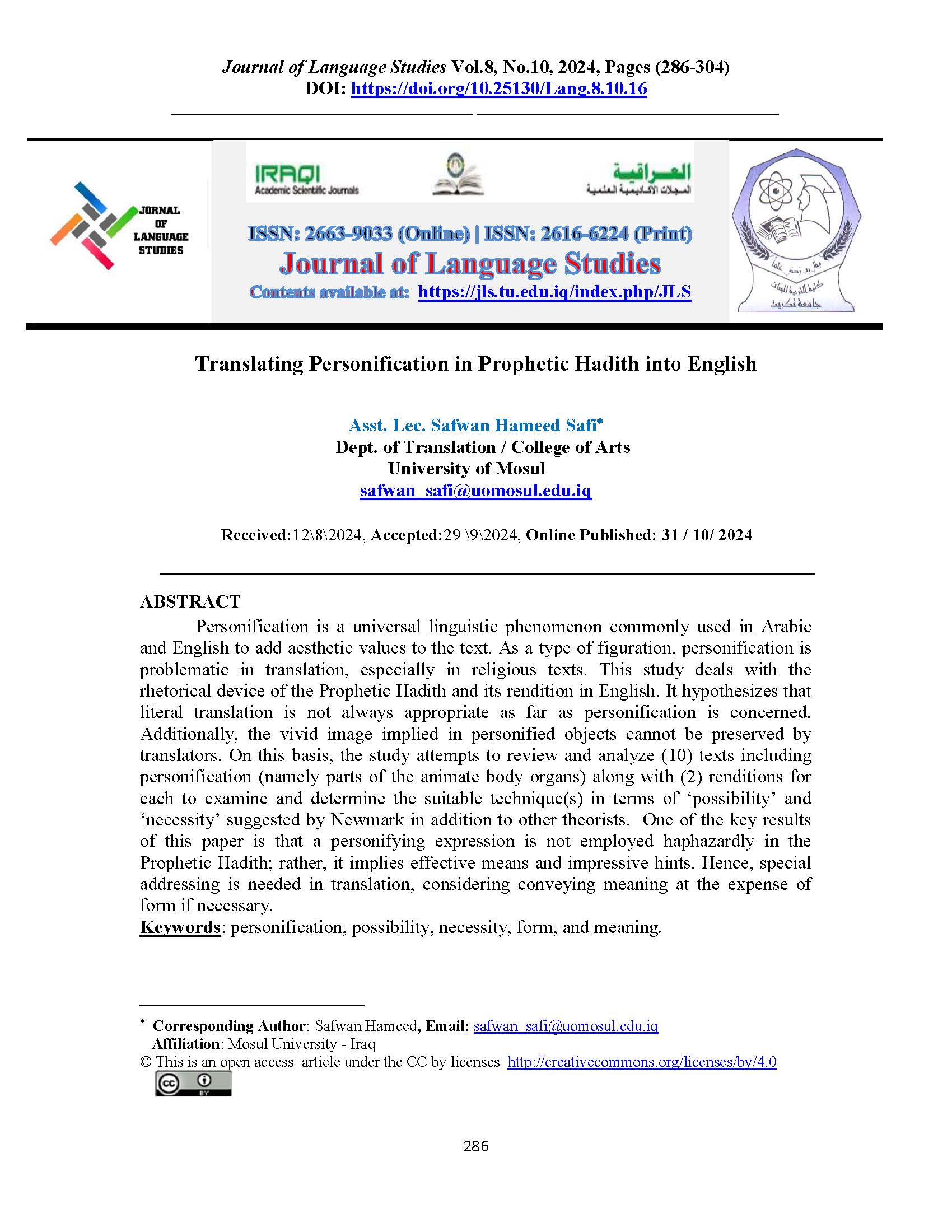Translating Personification in Prophetic Hadith into English
DOI:
https://doi.org/10.25130/Lang.8.10.16Keywords:
personification, possibility, necessity, form, and meaningAbstract
Personification is a universal linguistic phenomenon commonly used in Arabic and English to add aesthetic values to the text. As a type of figuration, personification is problematic in translation, especially in religious texts. This study deals with the rhetorical device of the Prophetic Hadith and its rendition in English. It hypothesizes that literal translation is not always appropriate as far as personification is concerned. Additionally, the vivid image implied in personified objects cannot be preserved by translators. On this basis, the study attempts to review and analyze (10) texts including personification (namely parts of the animate body organs) along with (2) renditions for each to examine and determine the suitable technique(s) in terms of ‘possibility’ and ‘necessity’ suggested by Newmark in addition to other theorists. One of the key results of this paper is that a personifying expression is not employed haphazardly in the Prophetic Hadith; rather, it implies effective means and impressive hints. Hence, special addressing is needed in translation, considering conveying meaning at the expense of form if necessary.
References
Abdulkadir, H. O. A. (2021). Fi: Bala:ghat Al-Kalimah Al-Mufradah fi: Al-Hadith Al-Nabawi. In: mkda.journals. Vol. 38, No. 134. pp.: 571-598. Available at: https://mkda.journals.ekb.eg/.
Abu Khaliyl (trans.) (2007). Jami‘ At-Tirmidhi. 1st ed. Riyadh and New York: Darussalam Global Leaders in Islamic Books.
Al-Bukhari, M. I. (2002). Sahih Al-Bukhari. 1st ed. Damascus and Beirut: Dar Ibn Kathir lil-Tiba’a wal-Nashr wal-Tawzee’.
Al-Hamathani, A. H. Y. (1968). Sharh Maqamaat Al-Hamathani. Beirut: Dar Al-Turath.
Al-Tirmidhi, A. M. E. (n.d.). Jami‘ At-Tirmidhi. Riyadh: International Ideas Home for Publishing and Distribution.
Arkon, M. (1997). Naz’at Al-Ansanah fil-Fikr Al-Arabi. Trans.: Salih H. 1st ed. Beirut: Dar Al-Saqi.
At-Tabrizi, W. (1985). Mishkat Al-Masabih. 3rd ed. (edt.): Al-Albani, N. Beirut: Al-Maktab Al-Islami.
Baker, M. (1992). In Other Words: A Coursebook on Translation. 2nd ed., London and New York: Routledge.
Catford, J. C. (1965). A Linguistic Theory of Translation. Oxford: Oxford University Press
Charteris-Black, J. (2004). Corpus Approaches to Critical Metaphor Analysis. London: Palgrave Macmillan.
Cuddon, J. A. (1998). The Penguin Dictionary of Literary Terms and Literary Theories. 4th Ed., Oxford: Blackwell Publishers.
Dodson, J. R. (2008). The ‘Powers’ of Personification. De Gruyter. https://doi.org/10.1515/9783110209778
Hornby, A. S., et al. (1974). Oxford Advanced Learner’s Dictionary of Current English. Oxford: Oxford University Press.
House, J. (1997). Translation Quality Assessment: A Model Revisited. Tübingen: Narr.
Ibn Manẓoor, A. J. M. (2005). Lisan Al-Arab. 4th ed. Beirut: Dar Ṣadir Lil-Tiba‘ah wa Al-Nashr.
Ilyas, A. I. (1989). Theories of Translation (Theoretical Issues and Practical Implications). Mosul: Dar Al-Kutub lil-Tiba’a wal-Nashr at Mosul University.
Khan, M. (trans.) (1997). The Translation of the Meaning of Sahîh Al-Bukhâri: Arabic-English. Riyadh: Darussalam Publishers and Distributors.
Koller (1979). ‘Equivalence in Translation Theory’. Translated from German by A. Chesterman, In: A. Chesterman (ed.) (1989), pp. 99–104.
Malla, A. A. (2009). “Activity of Metaphor in the Linguistic Structure of Literature.” M.A. Thesis in Arabic Literature. Homs: Al-Baath University.
Muslim, M. H. (n.d.). Sahih Muslim (Al-Jāmi’ Al-Sahih). Beirut: Dar Al-Ma’rifah.
Nasser, L. A. (2023). Possibility and Necessity in Translating Dynamic Elements in the Arabic Novel “Al-Shahwan” into English. In: 3rd International Conference on Language and Education. DOI: http://doi.org/10.24086/ICLANGEDU2023/paper.936
Newmark, P. (1981). Approaches to Translation, Oxford and New York: Pergamon, republished 2001 by Shanghai Foreign Language Education Press.
Newmark, P. (1988). A Textbook of Translation, New York and London: Prentice Hall.
Nida, E. A. (1964). Toward a Science of Translating, Leiden: E. J. Brill.
Nida, E. A. and C. R. Taber (1969). The Theory and Practice of Translation, Leiden: E. J. Brill.
Peters, P. (2004). The Cambridge Guide to English Usage. Cambridge: Cambridge University Press.
Procter, P. et al. (1978). Longman Dictionary of Contemporary English. Beirut: Librairie du Liban.
Sabran, N. S. M., et al. (2020). Personification in Diwan Imam Shafi’i. In: International Journal of Academic Research in Business and Social Sciences, 10(5), 909–918.
Siddiqui, A. (trans.) (2009). Translation of Sahih Muslim. 1st ed. Version: 0911052238593859-30.
Sleiba, J. (1982). Al-Mu’jam Al-Falsafi bil-Alfadh Al-Arabiyya wal-Firansiyya wal-Engliziyya wal-Latiniyya. Beirut: Dar Al-Kitab Al-Lubnani.
Wahba, M. and Al-Muhandis, K. (1984). Mu’jam Al-Mustalahat Al-Lughawiyya fil-Lugha wal-Adab. 2nd ed. Beirut: Maktabat Lubnan.
Hamdan, M. I., & Hussein, G. M. (2024). “Applying Larson's Model To Assess the Quality of Two Translations of Antony Hope's Novel The Prisoner of Zenda into Arabic”. Journal of Language Studies, 8(1), 281-304.
Safi, S. H. & Farman, A. Y. (2023). “Translating the Particle ‘لام’ /laam/ in the Noble Qur’aan into English”. Journal of Language Studies, 8(1), 214-235.
Websites:
https://hadeethenc.com/ar/home
https://sunnah.com/bukhari:1617
https://sunnah.com/mishkat:2147
https://sunnah.com/mishkat:2177
https://sunnah.com/mishkat:2814
https://sunnah.com/mishkat:29
https://sunnah.com/riyadussalihin:1810
https://sunnah.com/riyadussalihin:1810
https://sunnah.com/search?q=%D9%82%D9%84%D8%A8+%D8%A7%D9%84%D9%82%D8%B1%D8%A2%D9%86
https://sunnah.com/virtues:19
https://www.almaany.com/ar/dict/ar-ar/%D8%B9%D8%A8%D8%A7%D8%AF%D8%A9/?
https://www.hadithbd.com/hadith/error/?id=5430
https://www.hadithbd.com/hadith/error/?id=85498
https://www.hadithbd.com/hadith/link/?id=56737
www.almaany.com

